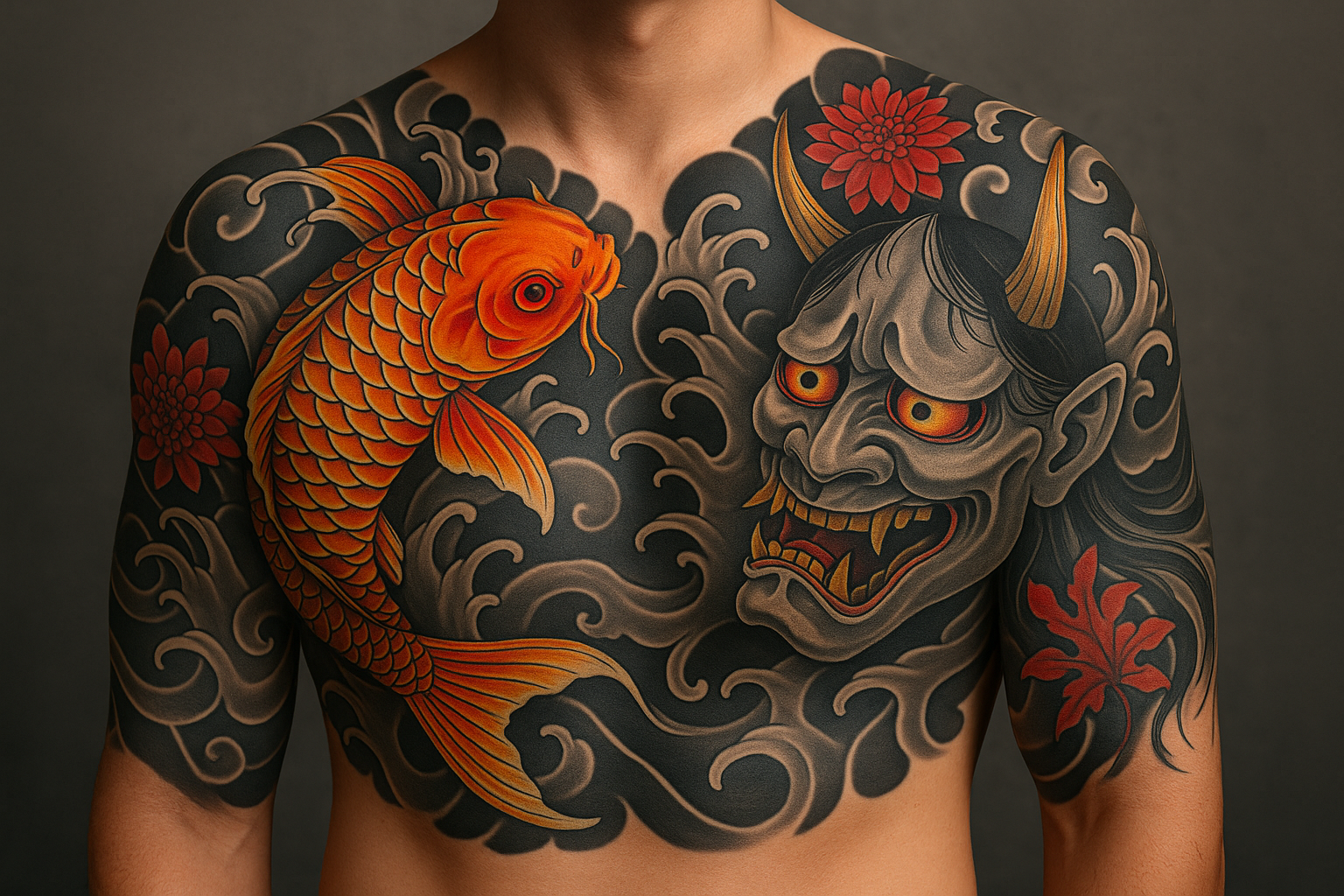A Horimono tattoo is not just a design — it’s a story inscribed in ink, pain, and purpose. In Japanese tradition, every symbol etched into the body carries weight: mythic, emotional, even karmic. You don’t just choose a Horimono tattoo — in many ways, it chooses you.
Before you commit to dragons, demons, or lotus blooms on your skin, you need to understand what they mean — and what they might awaken.
Here’s your essential guide to the most powerful Horimono symbols — from graceful koi fish to tormented Hannya masks — and why each one might be calling you.
🎏 Koi Fish (鯉) – Perseverance and Transformation
The koi is more than ornamental. In Japanese legend, a koi that swims upstream and climbs the waterfall becomes a dragon — the ultimate metamorphosis.
What it means:
- Unyielding spirit in the face of hardship
- Going against fate or social order
- Inner strength earned through trial
🧭 Best for: Those overcoming trauma, rising from betrayal, or seeking to claim power quietly but fully.
🐉 Dragon (龍) – Power, Wisdom, and Elemental Flow
Dragons in Japanese Horimono are protectors, not destroyers. They represent control over water, air, and chaos — powerful forces balanced by wisdom and restraint.
What it means:
- Guardian energy
- Mastery over the unseen
- Majestic leadership and inner strength
⚡ Best for: Natural-born protectors, leaders healing from rage, or those stepping into ancestral power.
🐅 Tiger (虎) – Courage and Ferocity
The tiger rules the earth, prowls without apology, and symbolizes raw instinct. In traditional sleeves, it’s often paired with the dragon to symbolize yin and yang.
What it means:
- Physical and emotional bravery
- Survival against odds
- Refusal to be tamed
🔥 Best for: Survivors. Warriors. People who fought through hell and kept their fangs.
😈 Hannya Mask (般若) – Jealousy, Obsession, and the Shadow Feminine
The Hannya represents a woman transformed by betrayal and sorrow into a demon. But she’s more than rage — she’s grief embodied. She’s pain given teeth.
What it means:
- Rage rooted in deep love
- Unhealed betrayal, possession, or sacrifice
- Complexity of feminine pain
👁️🗨️ Best for: Women reclaiming their rage. Those who turned their heartbreak into survival. Men honoring the ghosts they made.
🦋 Oni Demon (鬼) – Fear, Karma, and the Inner Monster
Oni are fearsome spirits — often depicted with horns, claws, and fierce expressions. In Horimono, they embody karmic consequences, unchecked urges, or ancestral burdens.
What it means:
- Confronting inner darkness
- Owning past sins
- Protecting through fear
💀 Best for: Those facing their own shadow work. People tired of running from what they carry.
🌸 Cherry Blossoms (桜) – Beauty in Impermanence
Sakura bloom for only a short time each year — and fall as quickly as they flourish. They’re reminders that all beauty is fleeting, and death is part of life.
What it means:
- Transience of youth or love
- Acceptance of change
- Grieving what cannot last
🌺 Best for: Lovers of imperfection. Those who lost someone. Those learning to let go.
🪷 Lotus (蓮) – Spiritual Rebirth and Purity from Pain
Lotus flowers bloom from the dirtiest mud — clean, whole, sacred. In Horimono, they represent spiritual clarity earned only through suffering.
What it means:
- Emotional rebirth after darkness
- Sacred feminine rising
- Clarity from pain
🕊️ Best for: Survivors of emotional abuse, grief, or shame. Those who made peace with their story.
🌊 Waves, Clouds, and Wind – The Background That Moves You
In Horimono, the background flow is just as meaningful as the main figure.
- Water: Emotional depth, movement, power
- Clouds: Divinity, mystery, ascent
- Wind bars (Karakusa): Unseen forces and energy
They don’t just fill space — they carry the story forward, wrapping around your body like memory.
🌬️ Best for: Letting your tattoo breathe. Letting pain flow instead of staying frozen.
🪓 Deities (Fudō Myōō, Kannon, etc.) – Divine Guidance and Protection
Some Horimono wearers choose to inscribe Buddhist deities or Shinto guardians — beings like:
- Fudō Myōō – The immovable wisdom king (anger transformed into protection)
- Kannon – Goddess of compassion (healer of grief and sorrow)
- Raijin/Fujin – Thunder and wind gods (chaos as transformation)
These figures don’t take lightly to being tattooed. In traditional circles, you must be ready to carry them — spiritually, emotionally, karmically.
📿 Best for: Those on a spiritual path, reclaiming ancestral protection, or battling invisible forces.
🖤 Final Thought: What You Wear, You Become
In Horimono, there is no meaningless tattoo. Every flower blooms with grief. Every demon has a name. Every dragon knows what it once was.
Your ink is your story — in symbols. In silence. In scars.
So before you get that koi or Hannya, ask yourself:
“Am I ready to live what this symbol means?”
Because in this tradition, you don’t just wear the tattoo. The tattoo wears you.
🧥 Want to Wear the Symbolism Before You Ink?
Not ready for a full sleeve — but feel the power of these symbols?
👉 Explore our Horimono-Inspired Shirt Collection
Designed with the meaning intact. Made for those who feel the myth stirring beneath their skin.


Leave a comment
Your email address will not be published. Required fields are marked *
You must be logged in to post a comment.